Thursday, 16 May 2013: Arles by audioguide
Written Wednesday, 29 May 2013
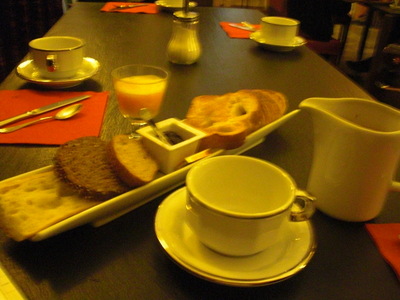
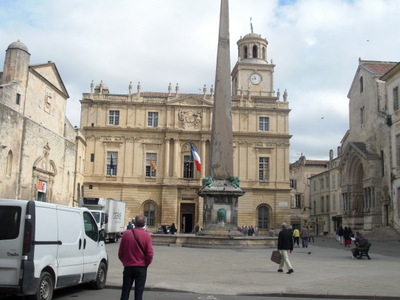 Breakfast at the Hotel Saint Trophime is all bread, all the time, but a nice variety thereof. Left to right: lengthwise baguette slice, chewy dark bread studded with sunflower and other seeds, rye (I think) studded with carraway seeds, pot of jam, thick slice of toasted brioche, and croissant. If two people came to breakfast together, they got twice as long a skinny platter. The flavor of jam varied from day to day. No decaf, so we drank chocolate.
Breakfast at the Hotel Saint Trophime is all bread, all the time, but a nice variety thereof. Left to right: lengthwise baguette slice, chewy dark bread studded with sunflower and other seeds, rye (I think) studded with carraway seeds, pot of jam, thick slice of toasted brioche, and croissant. If two people came to breakfast together, they got twice as long a skinny platter. The flavor of jam varied from day to day. No decaf, so we drank chocolate.
Down the hill and around the corner from the hotel was the Place de la République. In the background is the Hôtel de Ville (the Mairie), in the foreground is the stele from the Roman hippodrome (although the hippodrome wasn't located here; the stele was moved to this location), and to the right is the elaborate main door of the Church of Saint Trophime (first bishop of Arles, party to a miracle in which Christ himself showed up for the dedication of a local church).
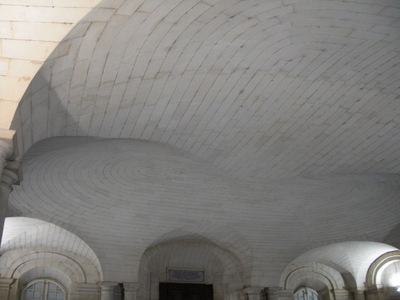
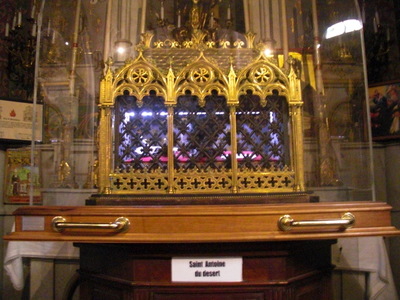 The Mairie's architectural claim to fame (at least above ground), is this amazing flat vaulted ceiling, just inside the main entrance. I understand theoretically that an arch (or, three-dimensionally, a vault) can be very wide and flat so long as the stones are fitted properly, but it's still incredible to see.
The Mairie's architectural claim to fame (at least above ground), is this amazing flat vaulted ceiling, just inside the main entrance. I understand theoretically that an arch (or, three-dimensionally, a vault) can be very wide and flat so long as the stones are fitted properly, but it's still incredible to see.
The church's main claim to fame is its adjoining cloisters, but inside the church itself is a truly amazing array of reliquaries. This one, in the central place of honor in the array, contains the skull of Saint Antoine du Desert (St. Anthony of the Desert). I'm afraid I don't know his story.
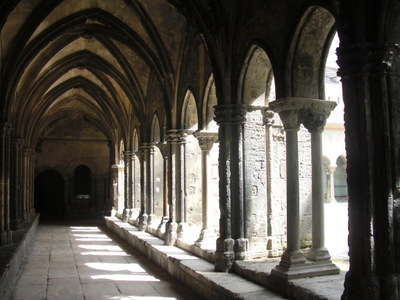
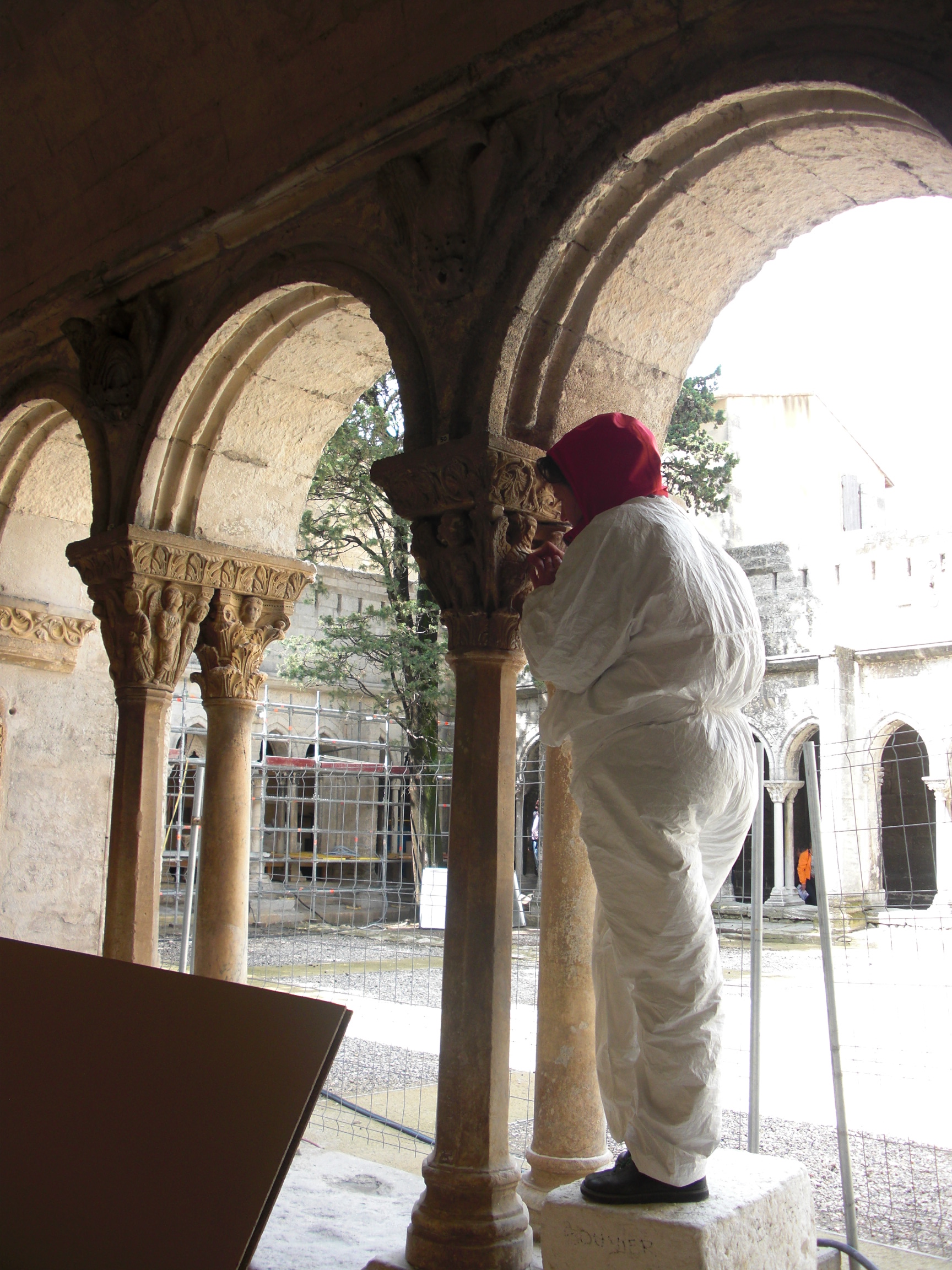 The cloisters were indeed beautiful. They were under renovation and cleaning, so parts of them were covered with scaffolding. The woman in the right-hand photo was cleaning the capital of one of the columns with a little pointed instrument about the size of a scalpel. We were hoping to watch the process and maybe even ask questions, but she was called away moments after we arrived and never came back. I don't know whether her delicate scraping process was the whole cleaning regimen or whether the surface was also sandblasted, before or after her part. The surface, once cleaned, was probably sealed in some way.
The cloisters were indeed beautiful. They were under renovation and cleaning, so parts of them were covered with scaffolding. The woman in the right-hand photo was cleaning the capital of one of the columns with a little pointed instrument about the size of a scalpel. We were hoping to watch the process and maybe even ask questions, but she was called away moments after we arrived and never came back. I don't know whether her delicate scraping process was the whole cleaning regimen or whether the surface was also sandblasted, before or after her part. The surface, once cleaned, was probably sealed in some way.
Workmen were also repointing the paving stones in the central courtyard, and inside a temporary structure built to surround some of the columns, they were doing something with lasers (because the doors bore prominent warning signs about eye damage and warned everyone not to open the doors or look in without eye protection).
Another unusual feature of the cloisters was that they were double-decker. A square spiral staircase led to the upper level, which was a open walkway around the square.
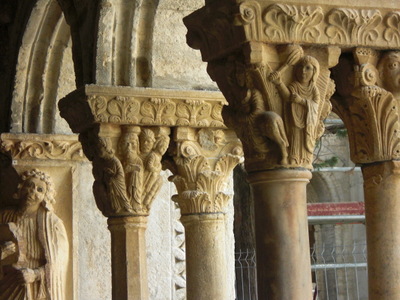
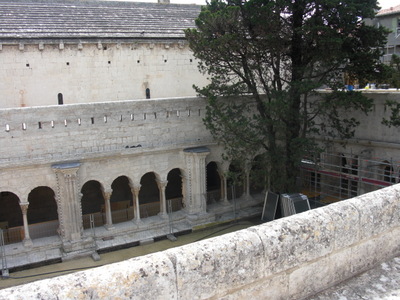 On the left is a view of some of the columns that had already been cleaned.
On the left is a view of some of the columns that had already been cleaned.
On the right is the view down into the central courtyard from the upper walkway. It and the surrounding roofs were served by a ramifying set of rain gutters built right into the stone. From the upper walkway, you could see how they converged to channel all the water to one corner of the courtyard and then downward (perhaps into cisterns?).
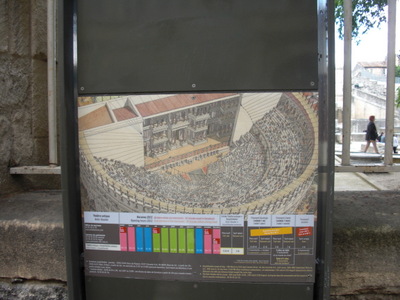
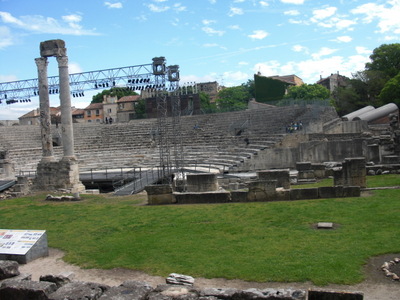 Next on our tour was the "antique theatre" (wonderfully rendered in translation as the "antic theater"), still in use today for concerts. As the artist's rendering in the left-hand photo shows, a Roman theater consisted of a semicircle of seating facing a stage with a tall "scene wall." They were usually built into hillsides to take advantage of natural half-bowl topography, but that wasn't practical in Arles, so this one was built entirely above ground, with three tiers of arches.
Next on our tour was the "antique theatre" (wonderfully rendered in translation as the "antic theater"), still in use today for concerts. As the artist's rendering in the left-hand photo shows, a Roman theater consisted of a semicircle of seating facing a stage with a tall "scene wall." They were usually built into hillsides to take advantage of natural half-bowl topography, but that wasn't practical in Arles, so this one was built entirely above ground, with three tiers of arches.
The two standing columns are all that remain of the scene wall, which originally incorporated about 100 columns on three levels. Most of the lower levels of seating are intact, and as you can see in the photo, the place was set up with a stage and lighting for some sort of performance.
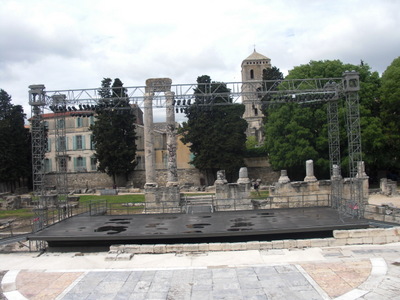
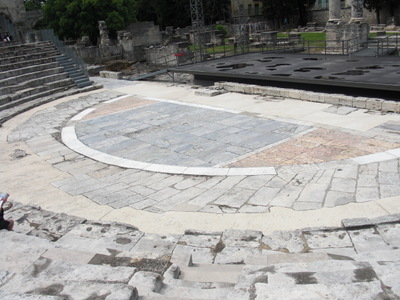 On the left is the view from the seating area toward the scene wall, and on the right is the view down into the "orchestra" section, where movable chairs would have been set up for the highest-ranking attendees. Theater performances (throughout the empire) were free and open to all, even slaves, although seating was strictly according to rank.
On the left is the view from the seating area toward the scene wall, and on the right is the view down into the "orchestra" section, where movable chairs would have been set up for the highest-ranking attendees. Theater performances (throughout the empire) were free and open to all, even slaves, although seating was strictly according to rank.
The theater was built in the 1st century B.C. by Augustus Caesar, shortly after Julius Caesar founded the town, and held 6000 spectators. Its most amazing feature in my eyes was the overhead system of ropes and cables, long gone now but visible in the artist's rendering, that permitted radial panels of canvas to be unfurled as needed to shade the audience!
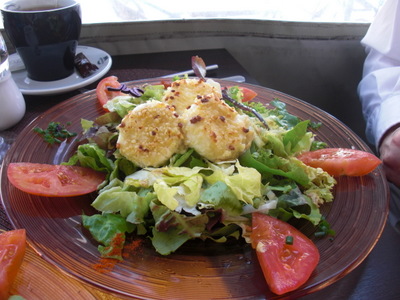
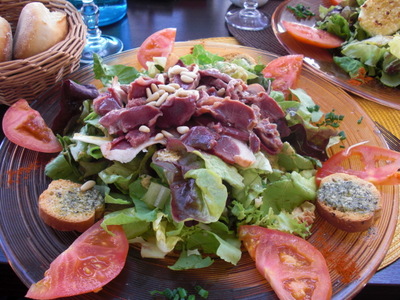 For lunch, we settled at Le Grillon (The Cricket), a little restaurant in the shadow of the Roman arena, which we planned to visit next. The theatre and arena, quite close together, were just up the hill and around the corner from our hotel.
For lunch, we settled at Le Grillon (The Cricket), a little restaurant in the shadow of the Roman arena, which we planned to visit next. The theatre and arena, quite close together, were just up the hill and around the corner from our hotel.
As usual, David got the salad with grilled goat cheese, this time, crusted with crushed almonds. I had a salad topped with duck magret, confit turkey gizzards, pine nuts, and little toasts drizzled with pistou. Excellent.
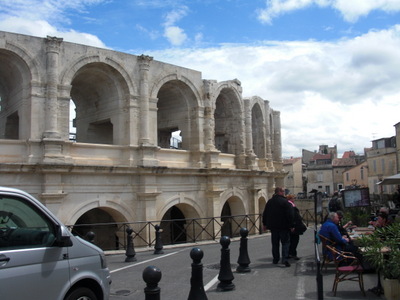
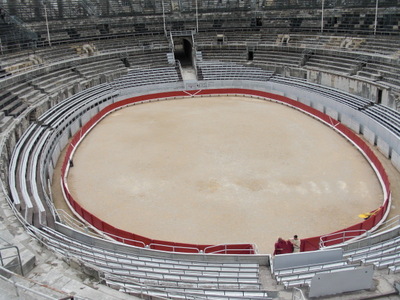 The arena was also built above ground, about the same time as the theater. That's our restaurant at the righthand side of the photo.
The arena was also built above ground, about the same time as the theater. That's our restaurant at the righthand side of the photo.
When we were there, it was rigged for bullfighting, though I'm not sure whether for traditional, lethal bullfights or the bloodless Camargue style. The former is still legal in some French cities. On the other hand, the guys in tunics and capes hanging around down there definitely weren't dressed for bullfighting.
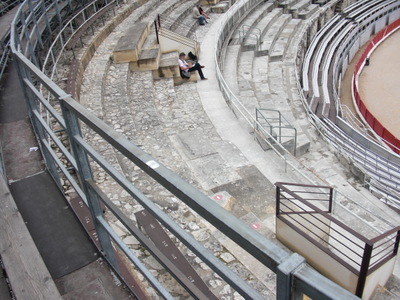
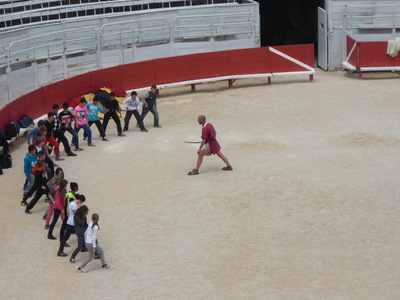 As you can see in the left-hand photo, where the original stone seating is intact, it's still used, but modern metal and wood bleachers have been mounted to fill gaps where the stones are gone.
As you can see in the left-hand photo, where the original stone seating is intact, it's still used, but modern metal and wood bleachers have been mounted to fill gaps where the stones are gone.
As we watched, listening to our audioguides, all was revealed. A couple of school groups arrived, and the guys in tunics and capes proceeded to line them up for lectures on gladiators (yes, actual gladiators used to fight here) and, better still (at least as far as holding their attention went), to teach them some basic gladiator moves, like the stance for sword-fighting, how to lunge properly, and whatnot.
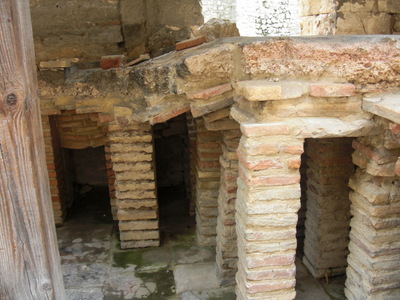
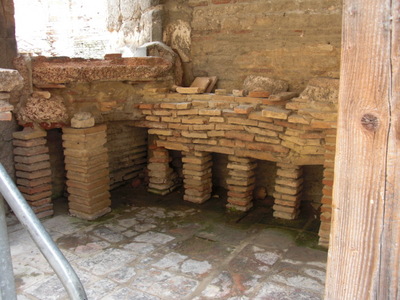 Next up were "Les Thermes de Constantin," Constantine's Baths, built in the 4th century A.D. under Emperor Constantine. They originally covered 3750 square meters, but only about 1100 are visible today. Some of the upper parts of the buildings are still standing, but as is typical of Roman ruins, it's mostly floor level and below that are preserved.
Next up were "Les Thermes de Constantin," Constantine's Baths, built in the 4th century A.D. under Emperor Constantine. They originally covered 3750 square meters, but only about 1100 are visible today. Some of the upper parts of the buildings are still standing, but as is typical of Roman ruins, it's mostly floor level and below that are preserved.
Here, you can see parts of the hypocaust, the system that circulated hot air under the floors of the rooms, producing (depending on the amount of heat allowed in) the cool, warm, and hot rooms. Soap was unknown to the Romans, so they cleaned their skin by "steam-bath," opening their pores, scraping off the sweat with instruments called strigils, then cooling the skin to close the pores again. The order of the process constituted a whole ritual and was often followed by socializing and recreational bathing.
The first Roman baths were built in Pompei, and the whole idea proved so popular that by 33 B.C., 170 had been built around the empire, and by the 4th century A.D., when these were built, the number was up to almost 1000. The largest were in Diocletian's baths in Rome, which covered about 15 ha and could accommodate 3000 people at a time!
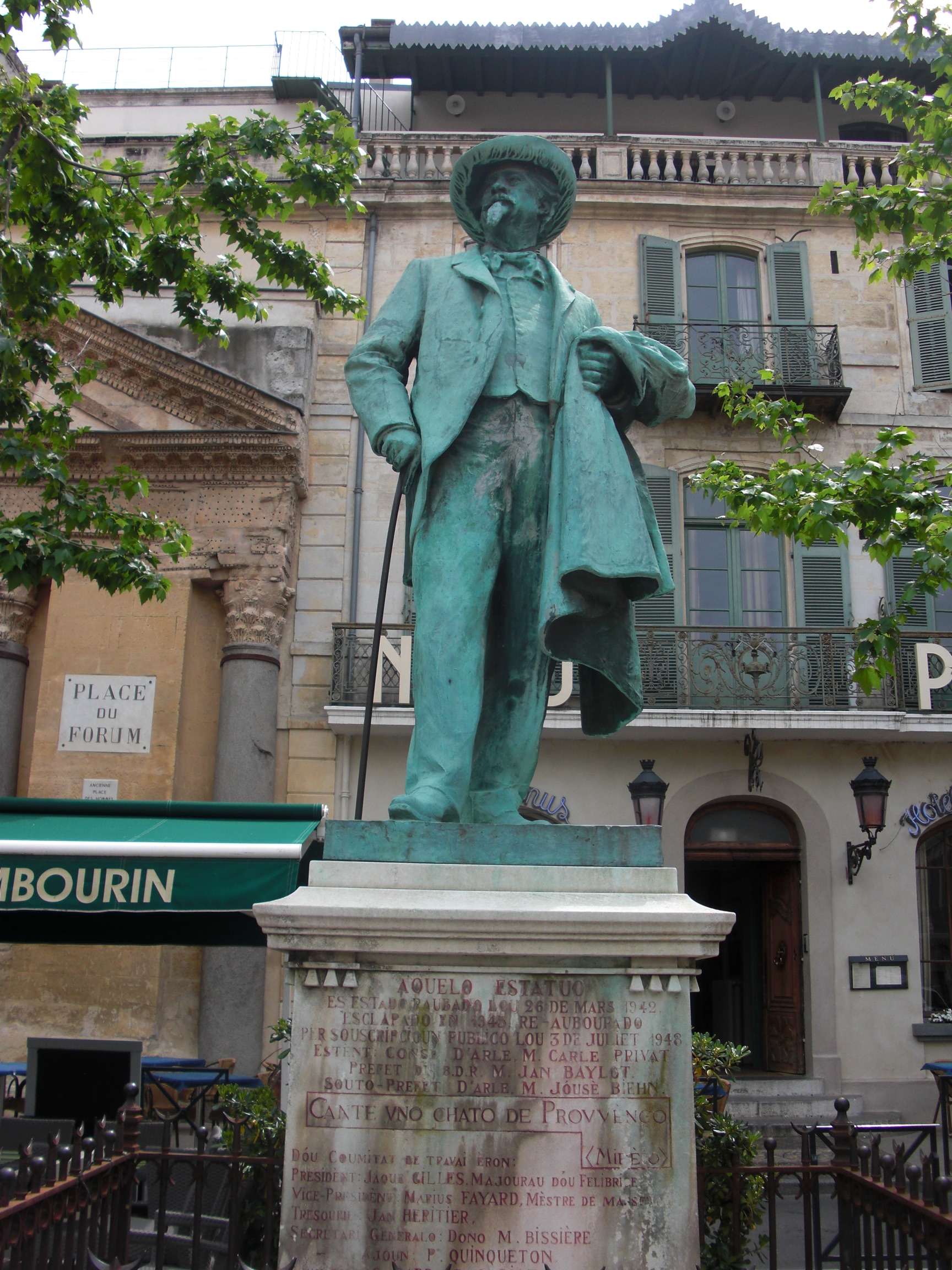
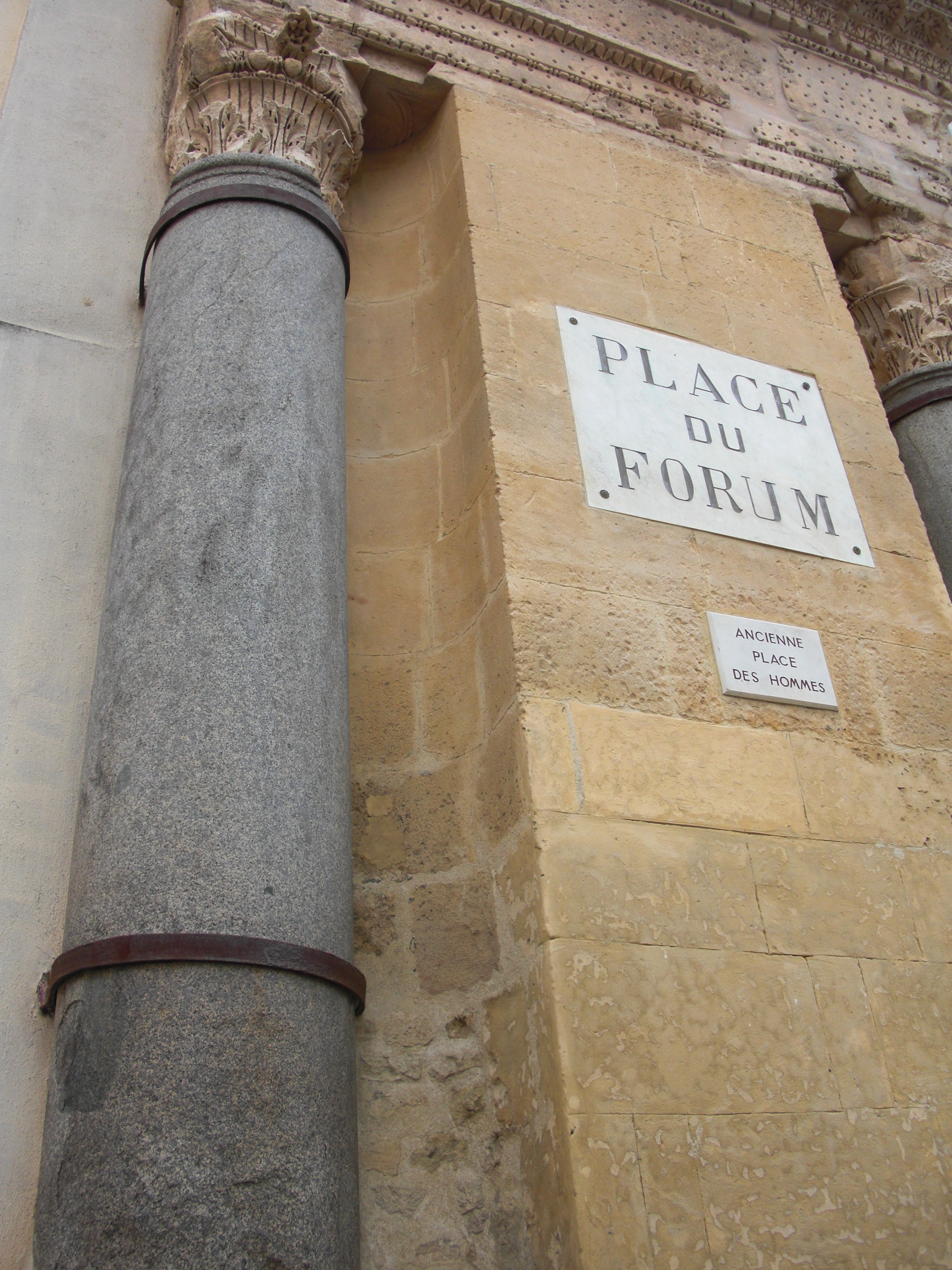 At this point, David's feet were about worn out, so he gave me his audioguide to return and headed back to the hotel while I went on to hit a few more of the high spots. This statue of Frédéric Mistral adorns the "Place du Forum," the site of the original Roman forum. We saw statues of Mistral everywhere we went in Provence. He was the greatest poet and champion of poetry written in Provençal; he even went so far as to change his name to "Mistral," after the famous (notorious!) Provençal wind, most recently immortalized by Peter Mayle in A Year in Provence.
At this point, David's feet were about worn out, so he gave me his audioguide to return and headed back to the hotel while I went on to hit a few more of the high spots. This statue of Frédéric Mistral adorns the "Place du Forum," the site of the original Roman forum. We saw statues of Mistral everywhere we went in Provence. He was the greatest poet and champion of poetry written in Provençal; he even went so far as to change his name to "Mistral," after the famous (notorious!) Provençal wind, most recently immortalized by Peter Mayle in A Year in Provence.
Above ground, all that remains of the forum is this pair of columns and part of the pediment they supported. They formed part of the entrance to the temple that was the focus of the forum. It's the rectangular, slighly elevated building in the middle in the artist's rendering below.
Today's Place, much smaller than the original forum was, is entirely filled with café tables; you have to weave among them to get far enough from either the statue or the columns to photograph them.
Under ground, though, much more remains. Because the ground slopes toward the river here, but the Romans wanted the forum to be level, they built a vast stone deck to carry it. The deck was at about ground level where the Mairie is, a block or two inland from the Place du Forum, but considerably above ground nearer the riverbank.
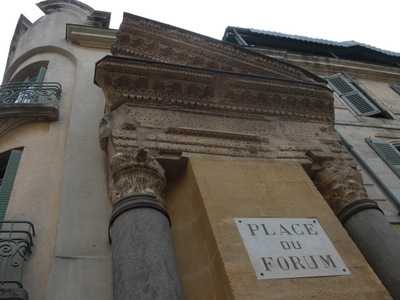
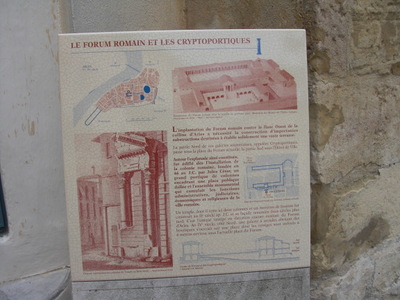 The space underneath, called the "cryptoportiques," is still there and can be toured. The entrance is in the Mairie. We never got there, but the diagram at the bottom of the panel at the right shows the profile of the space.
The space underneath, called the "cryptoportiques," is still there and can be toured. The entrance is in the Mairie. We never got there, but the diagram at the bottom of the panel at the right shows the profile of the space.
In the plan of the Roman town at the upper left on the panel, the blue oval is the arena, the blue semicircle the theater, and the rectangle the forum.
From there, I went looking for the Porte d'Auguste, Augustus's gate, but I never found it. I went by a route other than the one recommended by the audioguide (because I was also checking out traffic patterns for our return from dinner later), and for some reason, unlike all the other monuments, it wasn't marked on the city map. I found several likely doorways, though, and one of them was probably it. Anyway, it supposedly marks the house where Augustus Caesar was born.
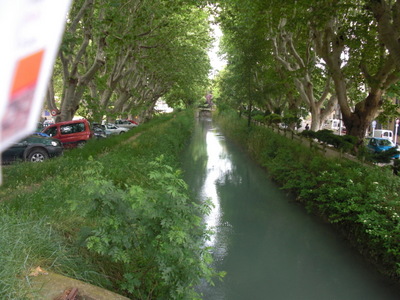
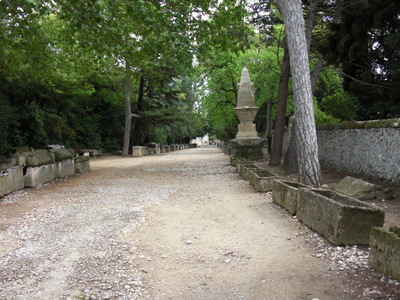 My feet were getting pretty tired, too, but before giving up, I wanted to see the Alyscamps, the Roman-era necropolis. To get there, you walk along this lovely stretch of canal. Today, the Alyscamps (the Latin form of "Champs Elysées," i.e., Elysian Fields) takes the form of a long, curving pathway lined on both sides with massive stone sarcophagi, dozens of them, some with their lids and some without, leading to a church at the far end, but in its heyday, it was much, much larger.
My feet were getting pretty tired, too, but before giving up, I wanted to see the Alyscamps, the Roman-era necropolis. To get there, you walk along this lovely stretch of canal. Today, the Alyscamps (the Latin form of "Champs Elysées," i.e., Elysian Fields) takes the form of a long, curving pathway lined on both sides with massive stone sarcophagi, dozens of them, some with their lids and some without, leading to a church at the far end, but in its heyday, it was much, much larger.
It was just one of several cemeteries around the town until, in about 250 A.D., Saint Genest was buried there. Genest was a local guy, a Roman clerk, who refused to sign death warrants during the period of persecution of Christians under the emperor Decius. He was arrested for it, got away, and tried to escape by swimming the Rhône, but the Roman guards caught him on the other side and summarily beheaded him. Anyway, he was an enormously popular saint, and when he was buried at the Alyscamps, suddenly everyone wanted to be buried there, as near him as possible. Families even had their already dead relatives exhumed and moved there, and the place became huge. It was such a big deal that it eventually became one of four designated departure points in France for pilgrimages to Santiago de Compostela—hence the stylized scallop shell portrayed on a stone plaque near the entrance (photo below right).
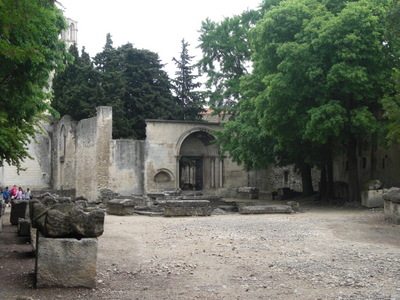
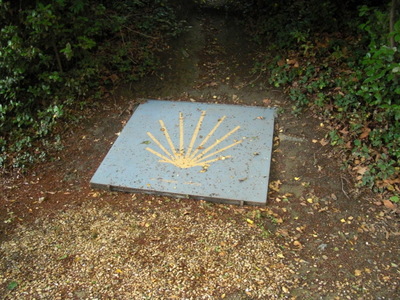 Later, though, most of the sarcophagi were lost, stolen, it seems, because they make perfect horse troughs, so only those lining the path today are left.
Later, though, most of the sarcophagi were lost, stolen, it seems, because they make perfect horse troughs, so only those lining the path today are left.
The pathway was presided over by two very friendly cats, who approached all passers by and allowed themselves to be ear-scratched and petted. Nice kitties.
Another reason that the Alyscamps are famous is that Van Gogh and Gaugin painted there together in the 1880's. Each day, they would set up under the trees along the pathway, one of them (Gaugin, I think) to paint the church and the other turning his back to the church to paint the trees! It was after a particularly violent quarrel between them that Van Gogh cut off his own ear and Gaugin left town precipitously.
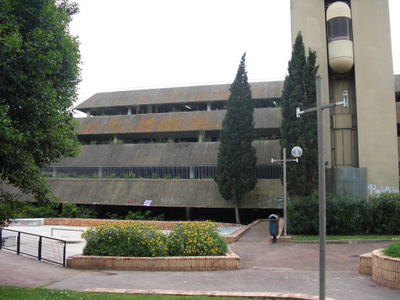
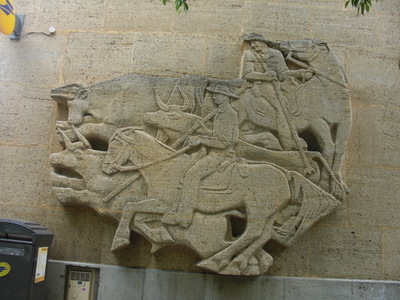 On my way back to the Office de Tourisme to turn in the audioguides, I passed the wonderful ziggurat-like parking structure, much more attractive, to my taste, than the average.
On my way back to the Office de Tourisme to turn in the audioguides, I passed the wonderful ziggurat-like parking structure, much more attractive, to my taste, than the average.
Also along the way was this sculpture, mounted on the outside wall of the post office, portraying the traditional round-up of the Camargue bulls by guys mounted on Camargue horses.
At this point, I would add that, if you're ever in Arles, don't bother with the city's audioguided tour—just use the map of monuments to locate the things worth seeing. I usually cannot sing the praises of audioguides loudly enough, and we encountered many on this trip that were so loaded with fascinating information that we ran out of time before we could listen to it all. But these were light-weight—only a dozen or so entries in all, and those mostly theater rather than information. Not worth even the nominal rental.
Written Wednesday, 2 June 2013
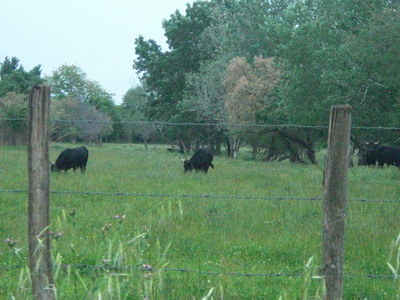
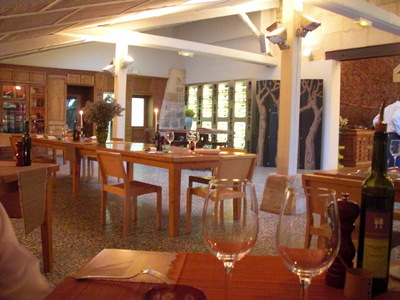 Dinner was at La Chassagnette, down in the Camargue, so we needed the car to get there. Our reservation was at 8 p.m., but the hotel's reserved parking is closed from 7 p.m. until 9 a.m., so we had to ask to have the car brought around at 7 p.m., lest it be locked in for the night. We therefore had time for another scenic drive before dinner. This time, we drove all the way down to Saintes-Maries-de-la-Mer, and there we found what we had expected at Salin de Giraud—a town set up for tourists and vacationers.
Dinner was at La Chassagnette, down in the Camargue, so we needed the car to get there. Our reservation was at 8 p.m., but the hotel's reserved parking is closed from 7 p.m. until 9 a.m., so we had to ask to have the car brought around at 7 p.m., lest it be locked in for the night. We therefore had time for another scenic drive before dinner. This time, we drove all the way down to Saintes-Maries-de-la-Mer, and there we found what we had expected at Salin de Giraud—a town set up for tourists and vacationers.
On the way, I finally got my photo of the bulls. On the right is the dining room at the restaurant. Again, when I ordered Evian, I was told they didn't stock it. They offered only filtered water. I was delighted and said so—filtered tap water is a much better (and cheaper and ecological sounder) idea than bottled mineral water—but he went through his little "better, cheaper, more ecologically sound" routine anyway. The water came in big cylindrical bottles labeled "Cryo." Apparently Cryo is a brand of filters that somebody is now selling to French restaurants; we saw the bottles filled from a tap with vertical handles like beer taps.
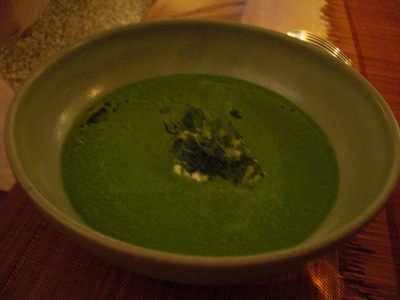
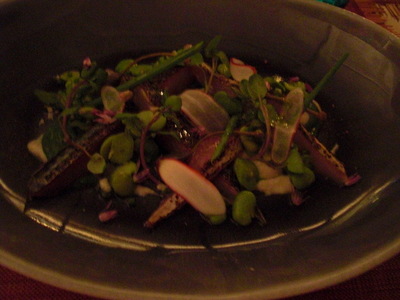 First course, David: Creamy soup of bitter herbs with sheeps-milk curds and pimpernel (an herb). I was surprised David ordered it, as he is not a fan of bitter greens, but it was delicious and he liked it.
First course, David: Creamy soup of bitter herbs with sheeps-milk curds and pimpernel (an herb). I was surprised David ordered it, as he is not a fan of bitter greens, but it was delicious and he liked it.
First course, me: "Lisettes," i.e., fresh young herrings. The fillets were grilled and served with baby broad beans, chives, green beans, paper-thin slices of radish, and "tonato" sauce (a tuna—yes, tuna—based mayonnaise usually served with veal).
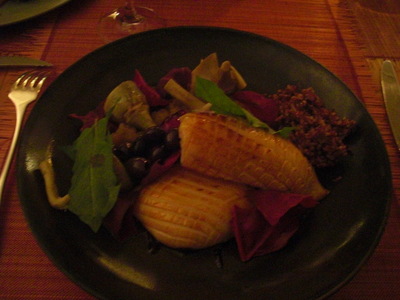
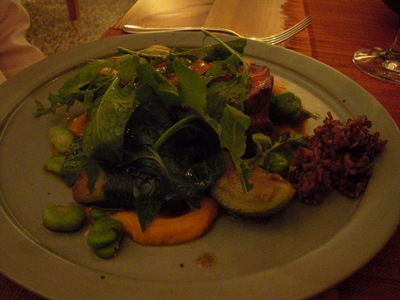 Main course, David: Sautéed lamb with carrot purée, broad beans, spherical zucchini, and wilted greens. On the side, a dollop of the delicious Camargue wild rice, from a big bowl they brought us to share. The chef is proud of his vegetable preparations, so on the menu, he lists the vegetables accompanying the dish first and the meat last.
Main course, David: Sautéed lamb with carrot purée, broad beans, spherical zucchini, and wilted greens. On the side, a dollop of the delicious Camargue wild rice, from a big bowl they brought us to share. The chef is proud of his vegetable preparations, so on the menu, he lists the vegetables accompanying the dish first and the meat last.
Main course, me: Cuttlefish, "first grilled, then glazed." The thick pieces were scored neatly into squares, which separated when the meat curled on the grill. On the side, mixed greens (some of which were pink), braised artichoke hearts, olives, and more of the Camargue rice. The texture of the cuttlefish was odd, not so much tough as crunchy.
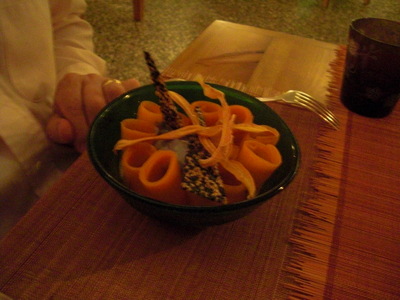
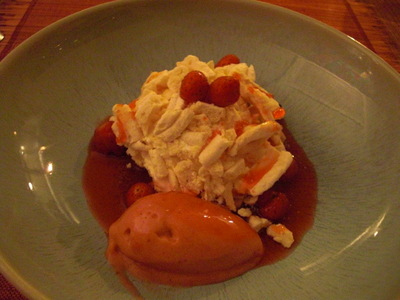 Dessert, David: Carrot panna cotta. David's very fond of panna cotta, but he was not thrilled with this one. It was entirely covered over with coiled strips of sweetened, mostly raw carrot, a few strips of brittle dried carrot, shards of sesame brittle, and a scoop of black sesame ice cream, all of which he said completely overpowered the panna cotta itself, down in the bottom of the bowl. It may have been carrot flavored, but it was hard to tell.
Dessert, David: Carrot panna cotta. David's very fond of panna cotta, but he was not thrilled with this one. It was entirely covered over with coiled strips of sweetened, mostly raw carrot, a few strips of brittle dried carrot, shards of sesame brittle, and a scoop of black sesame ice cream, all of which he said completely overpowered the panna cotta itself, down in the bottom of the bowl. It may have been carrot flavored, but it was hard to tell.
Dessert, me: Strawberry vacherin, i.e., vanilla ice cream, smothered in whipped cream and pieces of crisp meringue, drizzled with thyme-flavored caramel syrup, and served in a pool of poached strawberries. Orange sorbet on the side. Excellent.
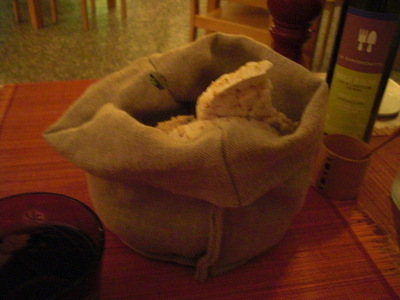 The bread came in this small gunny sack and included, as you can see, rice cakes (which were not quite crisp enough; they could have used 15 minutes in a slow oven).
The bread came in this small gunny sack and included, as you can see, rice cakes (which were not quite crisp enough; they could have used 15 minutes in a slow oven).
All in all, we thought the chef was trying a little too hard. A good dinner, but not a great one.
Then we had the car to deal with. The hotel's parking garage was closed for the night, but the proprietor had said it would be easy to park on the street. I had scoped out a few possible places, but David suggested we just park down on the broad boulevard south of the old town, rather than getting tangled in all the tiny one-way streets nearer the hotel. We found an area right in front of the Office de Tourism with lots of spaces, so we squeezed the car in through the narrow opening between the bollards outlining it, parked among the other handful of cars, and walked back to the hotel. The lot where we parked seemed to be free, but I made a mental note to come down about 9 a.m. the next day (when parking enforcement started) to make sure we hadn't overlooked a pay-and-display feature.
previous entry
List of Entries
next entry

 Breakfast at the Hotel Saint Trophime is all bread, all the time, but a nice variety thereof. Left to right: lengthwise baguette slice, chewy dark bread studded with sunflower and other seeds, rye (I think) studded with carraway seeds, pot of jam, thick slice of toasted brioche, and croissant. If two people came to breakfast together, they got twice as long a skinny platter. The flavor of jam varied from day to day. No decaf, so we drank chocolate.
Breakfast at the Hotel Saint Trophime is all bread, all the time, but a nice variety thereof. Left to right: lengthwise baguette slice, chewy dark bread studded with sunflower and other seeds, rye (I think) studded with carraway seeds, pot of jam, thick slice of toasted brioche, and croissant. If two people came to breakfast together, they got twice as long a skinny platter. The flavor of jam varied from day to day. No decaf, so we drank chocolate.
 The Mairie's architectural claim to fame (at least above ground), is this amazing flat vaulted ceiling, just inside the main entrance. I understand theoretically that an arch (or, three-dimensionally, a vault) can be very wide and flat so long as the stones are fitted properly, but it's still incredible to see.
The Mairie's architectural claim to fame (at least above ground), is this amazing flat vaulted ceiling, just inside the main entrance. I understand theoretically that an arch (or, three-dimensionally, a vault) can be very wide and flat so long as the stones are fitted properly, but it's still incredible to see.
 The cloisters were indeed beautiful. They were under renovation and cleaning, so parts of them were covered with scaffolding. The woman in the right-hand photo was cleaning the capital of one of the columns with a little pointed instrument about the size of a scalpel. We were hoping to watch the process and maybe even ask questions, but she was called away moments after we arrived and never came back. I don't know whether her delicate scraping process was the whole cleaning regimen or whether the surface was also sandblasted, before or after her part. The surface, once cleaned, was probably sealed in some way.
The cloisters were indeed beautiful. They were under renovation and cleaning, so parts of them were covered with scaffolding. The woman in the right-hand photo was cleaning the capital of one of the columns with a little pointed instrument about the size of a scalpel. We were hoping to watch the process and maybe even ask questions, but she was called away moments after we arrived and never came back. I don't know whether her delicate scraping process was the whole cleaning regimen or whether the surface was also sandblasted, before or after her part. The surface, once cleaned, was probably sealed in some way.
 On the left is a view of some of the columns that had already been cleaned.
On the left is a view of some of the columns that had already been cleaned.
 Next on our tour was the "antique theatre" (wonderfully rendered in translation as the "antic theater"), still in use today for concerts. As the artist's rendering in the left-hand photo shows, a Roman theater consisted of a semicircle of seating facing a stage with a tall "scene wall." They were usually built into hillsides to take advantage of natural half-bowl topography, but that wasn't practical in Arles, so this one was built entirely above ground, with three tiers of arches.
Next on our tour was the "antique theatre" (wonderfully rendered in translation as the "antic theater"), still in use today for concerts. As the artist's rendering in the left-hand photo shows, a Roman theater consisted of a semicircle of seating facing a stage with a tall "scene wall." They were usually built into hillsides to take advantage of natural half-bowl topography, but that wasn't practical in Arles, so this one was built entirely above ground, with three tiers of arches.
 On the left is the view from the seating area toward the scene wall, and on the right is the view down into the "orchestra" section, where movable chairs would have been set up for the highest-ranking attendees. Theater performances (throughout the empire) were free and open to all, even slaves, although seating was strictly according to rank.
On the left is the view from the seating area toward the scene wall, and on the right is the view down into the "orchestra" section, where movable chairs would have been set up for the highest-ranking attendees. Theater performances (throughout the empire) were free and open to all, even slaves, although seating was strictly according to rank.
 For lunch, we settled at Le Grillon (The Cricket), a little restaurant in the shadow of the Roman arena, which we planned to visit next. The theatre and arena, quite close together, were just up the hill and around the corner from our hotel.
For lunch, we settled at Le Grillon (The Cricket), a little restaurant in the shadow of the Roman arena, which we planned to visit next. The theatre and arena, quite close together, were just up the hill and around the corner from our hotel.
 The arena was also built above ground, about the same time as the theater. That's our restaurant at the righthand side of the photo.
The arena was also built above ground, about the same time as the theater. That's our restaurant at the righthand side of the photo.
 As you can see in the left-hand photo, where the original stone seating is intact, it's still used, but modern metal and wood bleachers have been mounted to fill gaps where the stones are gone.
As you can see in the left-hand photo, where the original stone seating is intact, it's still used, but modern metal and wood bleachers have been mounted to fill gaps where the stones are gone.
 Next up were "Les Thermes de Constantin," Constantine's Baths, built in the 4th century A.D. under Emperor Constantine. They originally covered 3750 square meters, but only about 1100 are visible today. Some of the upper parts of the buildings are still standing, but as is typical of Roman ruins, it's mostly floor level and below that are preserved.
Next up were "Les Thermes de Constantin," Constantine's Baths, built in the 4th century A.D. under Emperor Constantine. They originally covered 3750 square meters, but only about 1100 are visible today. Some of the upper parts of the buildings are still standing, but as is typical of Roman ruins, it's mostly floor level and below that are preserved.
 At this point, David's feet were about worn out, so he gave me his audioguide to return and headed back to the hotel while I went on to hit a few more of the high spots. This statue of Frédéric Mistral adorns the "Place du Forum," the site of the original Roman forum. We saw statues of Mistral everywhere we went in Provence. He was the greatest poet and champion of poetry written in Provençal; he even went so far as to change his name to "Mistral," after the famous (notorious!) Provençal wind, most recently immortalized by Peter Mayle in A Year in Provence.
At this point, David's feet were about worn out, so he gave me his audioguide to return and headed back to the hotel while I went on to hit a few more of the high spots. This statue of Frédéric Mistral adorns the "Place du Forum," the site of the original Roman forum. We saw statues of Mistral everywhere we went in Provence. He was the greatest poet and champion of poetry written in Provençal; he even went so far as to change his name to "Mistral," after the famous (notorious!) Provençal wind, most recently immortalized by Peter Mayle in A Year in Provence.
 The space underneath, called the "cryptoportiques," is still there and can be toured. The entrance is in the Mairie. We never got there, but the diagram at the bottom of the panel at the right shows the profile of the space.
The space underneath, called the "cryptoportiques," is still there and can be toured. The entrance is in the Mairie. We never got there, but the diagram at the bottom of the panel at the right shows the profile of the space.
 My feet were getting pretty tired, too, but before giving up, I wanted to see the Alyscamps, the Roman-era necropolis. To get there, you walk along this lovely stretch of canal. Today, the Alyscamps (the Latin form of "Champs Elysées," i.e., Elysian Fields) takes the form of a long, curving pathway lined on both sides with massive stone sarcophagi, dozens of them, some with their lids and some without, leading to a church at the far end, but in its heyday, it was much, much larger.
My feet were getting pretty tired, too, but before giving up, I wanted to see the Alyscamps, the Roman-era necropolis. To get there, you walk along this lovely stretch of canal. Today, the Alyscamps (the Latin form of "Champs Elysées," i.e., Elysian Fields) takes the form of a long, curving pathway lined on both sides with massive stone sarcophagi, dozens of them, some with their lids and some without, leading to a church at the far end, but in its heyday, it was much, much larger. 
 Later, though, most of the sarcophagi were lost, stolen, it seems, because they make perfect horse troughs, so only those lining the path today are left.
Later, though, most of the sarcophagi were lost, stolen, it seems, because they make perfect horse troughs, so only those lining the path today are left.
 On my way back to the Office de Tourisme to turn in the audioguides, I passed the wonderful ziggurat-like parking structure, much more attractive, to my taste, than the average.
On my way back to the Office de Tourisme to turn in the audioguides, I passed the wonderful ziggurat-like parking structure, much more attractive, to my taste, than the average.
 Dinner was at La Chassagnette, down in the Camargue, so we needed the car to get there. Our reservation was at 8 p.m., but the hotel's reserved parking is closed from 7 p.m. until 9 a.m., so we had to ask to have the car brought around at 7 p.m., lest it be locked in for the night. We therefore had time for another scenic drive before dinner. This time, we drove all the way down to Saintes-Maries-de-la-Mer, and there we found what we had expected at Salin de Giraud—a town set up for tourists and vacationers.
Dinner was at La Chassagnette, down in the Camargue, so we needed the car to get there. Our reservation was at 8 p.m., but the hotel's reserved parking is closed from 7 p.m. until 9 a.m., so we had to ask to have the car brought around at 7 p.m., lest it be locked in for the night. We therefore had time for another scenic drive before dinner. This time, we drove all the way down to Saintes-Maries-de-la-Mer, and there we found what we had expected at Salin de Giraud—a town set up for tourists and vacationers. 
 First course, David: Creamy soup of bitter herbs with sheeps-milk curds and pimpernel (an herb). I was surprised David ordered it, as he is not a fan of bitter greens, but it was delicious and he liked it.
First course, David: Creamy soup of bitter herbs with sheeps-milk curds and pimpernel (an herb). I was surprised David ordered it, as he is not a fan of bitter greens, but it was delicious and he liked it.
 Main course, David: Sautéed lamb with carrot purée, broad beans, spherical zucchini, and wilted greens. On the side, a dollop of the delicious Camargue wild rice, from a big bowl they brought us to share. The chef is proud of his vegetable preparations, so on the menu, he lists the vegetables accompanying the dish first and the meat last.
Main course, David: Sautéed lamb with carrot purée, broad beans, spherical zucchini, and wilted greens. On the side, a dollop of the delicious Camargue wild rice, from a big bowl they brought us to share. The chef is proud of his vegetable preparations, so on the menu, he lists the vegetables accompanying the dish first and the meat last.
 Dessert, David: Carrot panna cotta. David's very fond of panna cotta, but he was not thrilled with this one. It was entirely covered over with coiled strips of sweetened, mostly raw carrot, a few strips of brittle dried carrot, shards of sesame brittle, and a scoop of black sesame ice cream, all of which he said completely overpowered the panna cotta itself, down in the bottom of the bowl. It may have been carrot flavored, but it was hard to tell.
Dessert, David: Carrot panna cotta. David's very fond of panna cotta, but he was not thrilled with this one. It was entirely covered over with coiled strips of sweetened, mostly raw carrot, a few strips of brittle dried carrot, shards of sesame brittle, and a scoop of black sesame ice cream, all of which he said completely overpowered the panna cotta itself, down in the bottom of the bowl. It may have been carrot flavored, but it was hard to tell. The bread came in this small gunny sack and included, as you can see, rice cakes (which were not quite crisp enough; they could have used 15 minutes in a slow oven).
The bread came in this small gunny sack and included, as you can see, rice cakes (which were not quite crisp enough; they could have used 15 minutes in a slow oven).